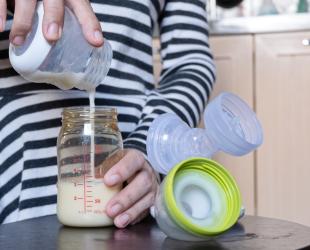Breastmilk can look or smell different - here's what's normal and when to seek advice

It’s common for breastmilk to look or smell different sometimes, and it’s usually nothing to worry about. Most mums only notice the colour of their milk when they express.
If your breastmilk looks different from what you expected, you might feel concerned. Here’s what you need to know.
Colostrum (the first milk) is usually yellowish. Mature breastmilk is often bluish-white but there’s a wide range of normal.
Sometimes your breastmilk may change colour as a result of foods and drinks with strong colours or food dyes. Some medications can also affect breastmilk colour.
Unusual colours of breastmilk
- Pink: Eating lots of beetroot or other red foods. Sometimes, pink means blood is present (see below under 'Blood in breastmilk'. Rarely, bright pink stains can be caused by a bacterium called Serratia marcescens. If you see this, talk to your doctor.
- Yellow or orange: Eating lots of carrots, pumpkin, or other orange foods.
- Green: Eating lots of green vegetables, seaweed, or foods with green or blue dyes.
- Black: Some medications (like Minocycline for acne) or blood.
- Red or brown: Usually means blood is present (see below).
- Bright white lumps: This is just the cream rising to the top after breastmilk sits for a while.
Most of the time, changes in breastmilk colour are harmless. If you’re worried, check with your doctor or child health nurse.
Blood in breastmilk
Blood in breastmilk is usually not serious, but again, it’s a good idea to check with your doctor. Milk may be bright red, pink, coffee/chocolate brown, black or olive-green colour.
- Common causes: Cracked nipples, or a small benign growth in a milk duct (intraductal papilloma).
- After birth: Blood-stained milk in the first days is called ‘rusty pipe syndrome’. Scientists think it’s due to the growth of the ducts and milk-making cells in the breast. It usually goes away after about a week.
- Baby’s reaction: Sometimes babies spit up blood-stained milk or have dark poos. This is usually from swallowing blood in the milk, not from the baby. Swallowed blood isn’t harmful but can irritate the stomach. Again, check with your doctor in this situation.
Why does my breastmilk smell or taste different
- Diet: Your milk may smell like foods you’ve eaten (like garlic). This is one of the good things about breastfeeding. Your baby is learning about the flavours in your family diet even before they start solids!
- Storage: Sometimes, milk absorbs smells from the fridge or containers. If stored correctly, it’s safe to use.
- Soapy or ‘off’ smell or taste: This can sometimes happen due to oxidation following the normal action of a fat-digesting enzyme called lipase. The milk is still safe to feed your baby and most babies won’t even notice. If your baby does refuse the milk, you can stop it happening by scalding your milk as soon as you express it. To scald breastmilk, heat until only close to boiling (not in the microwave) then cool it quickly by placing the container into a bowl or sink of ice and water. Then store your milk as usual. Only do this if your baby won’t drink the milk, as scalding removes some immune benefits.
© Australian Breastfeeding Association November 2025
Beckerman, J. P., Slade, E., & Ventura, A. K. (2020). Maternal diet during lactation and breast-feeding practices have synergistic association with child diet at 6 years. Public Health Nutrition, 23(2), 286–294.
Eglash, A., Simon, L., & Academy of Breastfeeding Medicine. (2017). ABM Clinical Protocol #8: Human milk storage information for home use for full-term infants, revised 2017. Breastfeeding Medicine, 12(7), 390–395.
Quinn, L., Ailsworth, M., Matthews, E., Kellams, A., & Shirley, D. A. (2018). Serratia marcescens colonization causing pink breast milk and pink diapers: A case report and literature review. Breastfeeding Medicine, 13(5), 388–394. https://doi.org/10.1089/bfm.2018.0002
Spahn, J. M., Callahan, E. H., Spill, M. K., Wong, Y. P., Benjamin-Neelon, S. E., Birch, L., Black, M. M., Cook, J. T., Faith, M. S., Mennella, J. A., & Casavale, K. O. (2019). Influence of maternal diet on flavor transfer to amniotic fluid and breast milk and children’s responses: A systematic review. American Journal of Clinical Nutrition, 109(Suppl_7), 1003S–1026S.
Spitzer, J., Doucet, S., & Buettner, A. (2010). The influence of storage conditions on flavour changes in human milk. Food Quality and Preference, 21(8), 998-1007.
Tang, H., Zhu, W., Chen, J., & Zhang, D. (2022). Rusty pipe syndrome: A case report and review of the literature. BMC Pregnancy and Childbirth, 22(1), 770.


